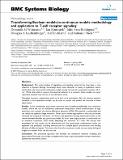Transforming Boolean models to continuous models: methodology and application to T-cell receptor signaling
Author(s)
Wittmann, Dominik M.; Krumsiek, Jan; Saez-Rodriguez, Julio; Lauffenburger, Douglas A.; Klamt, Steffen; Theis, Fabian J.; ... Show more Show less
DownloadWittmann-2009-Transforming Boolean.pdf (1.754Mb)
PUBLISHER_CC
Publisher with Creative Commons License
Creative Commons Attribution
Terms of use
Metadata
Show full item recordAbstract
Background
The understanding of regulatory and signaling networks has long been a core objective in Systems Biology. Knowledge about these networks is mainly of qualitative nature, which allows the construction of Boolean models, where the state of a component is either 'off' or 'on'. While often able to capture the essential behavior of a network, these models can never reproduce detailed time courses of concentration levels.
Nowadays however, experiments yield more and more quantitative data. An obvious question therefore is how qualitative models can be used to explain and predict the outcome of these experiments.
Results
In this contribution we present a canonical way of transforming Boolean into continuous models, where the use of multivariate polynomial interpolation allows transformation of logic operations into a system of ordinary differential equations (ODE). The method is standardized and can readily be applied to large networks. Other, more limited approaches to this task are briefly reviewed and compared. Moreover, we discuss and generalize existing theoretical results on the relation between Boolean and continuous models. As a test case a logical model is transformed into an extensive continuous ODE model describing the activation of T-cells. We discuss how parameters for this model can be determined such that quantitative experimental results are explained and predicted, including time-courses for multiple ligand concentrations and binding affinities of different ligands. This shows that from the continuous model we may obtain biological insights not evident from the discrete one.
Conclusion
The presented approach will facilitate the interaction between modeling and experiments. Moreover, it provides a straightforward way to apply quantitative analysis methods to qualitatively described systems.
Date issued
2009-09Department
Massachusetts Institute of Technology. Department of Biological EngineeringJournal
BMC Systems Biology
Publisher
BioMed Central Ltd.
Citation
Wittmann, Dominik et al. “Transforming Boolean models to continuous models: methodology and application to T-cell receptor signaling.” BMC Systems Biology 3.1 (2009): 98.
Version: Final published version
ISSN
1752-0509